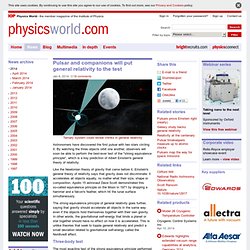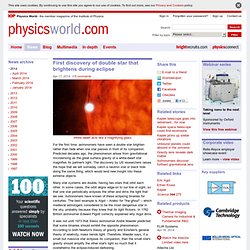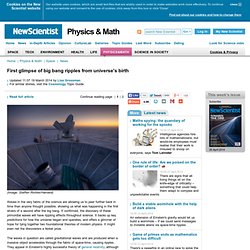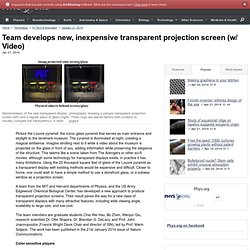

CERN discovers two new subatomic particles. Pulsar and companions will put general relativity to the test. Astronomers have discovered the first pulsar with two stars circling it.

By watching the three objects orbit one another, observers will soon be able to perform the best-ever test of the "strong equivalence principle", which is a key prediction of Albert Einstein's general theory of relativity. Like the Newtonian theory of gravity that came before it, Einstein's general theory of relativity says that gravity does not discriminate: it accelerates all objects equally, no matter what their size, shape or composition.
Apollo 15 astronaut Dave Scott demonstrated this so-called equivalence principle on the Moon in 1971 by dropping a hammer and a falcon's feather, which hit the lunar surface simultaneously. The strong equivalence principle of general relativity goes further, saying that gravity should accelerate all objects in the same way even if the objects hold themselves together with their own gravity. Three-body test Extraordinary and very rare. First discovery of double star that brightens during eclipse. For the first time, astronomers have seen a double star brighten rather than fade when one star passes in front of its companion.

Predicted decades ago, the phenomenon arises from gravitational microlensing as the great surface gravity of a white-dwarf star magnifies its partner's light. The discovery by US researchers raises the hope that we will someday catch a neutron star or black hole doing the same thing, which would lend new insight into these extreme objects. Many star systems are double, having two stars that orbit each other. In some cases, the orbit aligns edge-on to our line of sight, so that one star periodically eclipses the other and dims the light that we see. BICEP2 2014 Results Release. First glimpse of big bang ripples from universe's birth. Read full article Continue reading page |1|2 (Image: Steffen Richter/Harvard) Waves in the very fabric of the cosmos are allowing us to peer further back in time than anyone thought possible, showing us what was happening in the first slivers of a second after the big bang.

If confirmed, the discovery of these primordial waves will have rippling effects throughout science. It backs up key predictions for how the universe began and operates, and offers a glimmer of hope for tying together two foundational theories of modern physics. The waves in question are called gravitational waves and are produced when a massive object accelerates through the fabric of space-time, causing ripples. Today, scientists working with the BICEP2 collaboration at the south pole announced the first clear sign of gravitational waves, found in maps of the earliest light emitted after the big bang. Nobel-prize material Marc Kamionkowski at Johns Hopkins University in Baltimore, Maryland, is even more effusive. Stanford Professor Andrei Linde celebrates physics breakthrough.
Cern scientists create antihydrogen atoms. Team develops new, inexpensive transparent projection screen. Picture the Louvre pyramid: the iconic glass pyramid that serves as main entrance and skylight to the landmark museum.

The pyramid is illuminated at night, creating a magical ambience. Imagine strolling next to it while a video about the museum is projected on the glass in front of you, adding information while preserving the elegance of the structure. This seems like a scene taken from The Avengers or other sci-fi movies: although some technology for transparent displays exists, in practice it has many limitations. Using the 20 thousand square feet of glass of the Louvre pyramid as a transparent display with existing methods would be expensive and difficult. Closer to home, one could wish to have a simple method to use a storefront glass, or a subway window as a projection screen.
A team from the MIT and Harvard departments of Physics, and the US Army Edgewood Chemical Biological Center, has developed a new approach to produce transparent projection screens. Color sensitive players. Transparent Displays at MIT. Time Travel Via Wormhole Breaks the Rules of Quantum Mechanics. Science has done it again everybody!

Brace yourselves for this groundbreaking news, freshly determined by physicists: Time travel, if it exists, may have some weird consequences. Gosh, who’d have thunk it? But no, seriously, a recent article suggests that a certain kind of theoretically possible time machine would wreak minor havoc with a firm principle of quantum mechanics, the often-weird science of the smallest bits of the universe. You know what this means: We get to explore the science of time travel!
Time Travel: No, Really Let’s get this out of the way first: Obviously time travel exists, because it’s already the third week of 2014. The “useful” kind of time travel, though, for sci-fi authors and dreamers alike, is into the past, Back to the Future style. Okay, so a wormhole-based time machine might actually be possible, if not necessarily very likely.
Quantum Confusion One of the defining (and enraging) qualities of the quantum world is how much uncertainty there is.